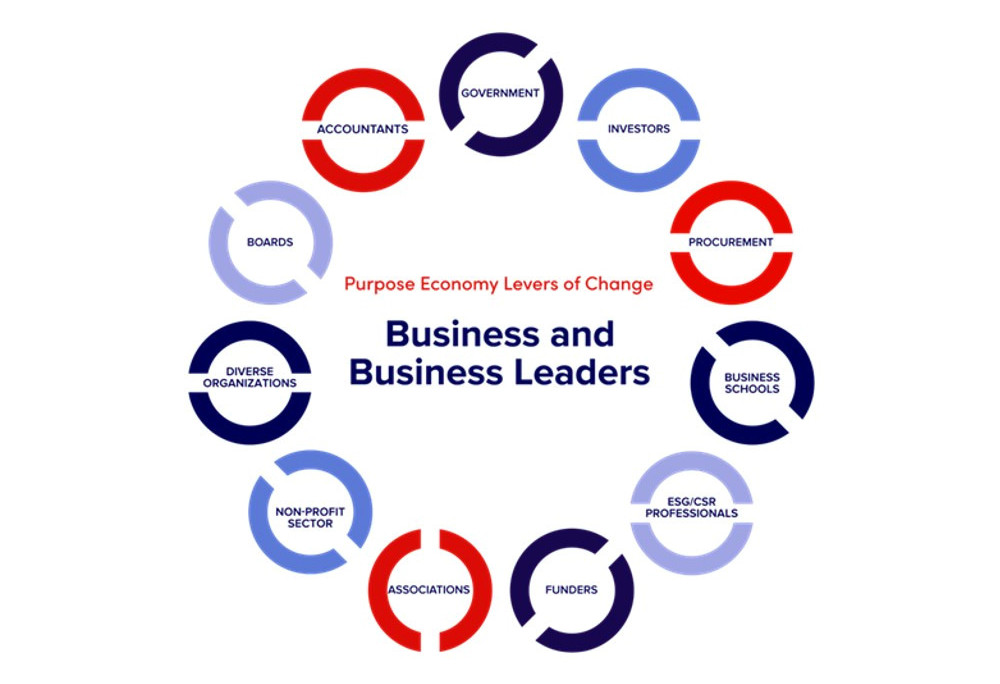The purpose ecosystem is coming of age. You can see this when you start
coming across academic research defining it and studying its potential and
constraints, when you watch it come to fruition through your or others’
deliberate
efforts, or
when over 100 CEOs of purpose-driven companies endorse a Call to
Purpose.
Academics studying this purpose-ecosystem phenomenon describe it as a
self-organizing community of organizations and interdependent stakeholders
organically seeking to promote wider system change through a shared intention to
enable business to have a purpose beyond profit (Dahlmann et
al
and Lyon et al).
In Canada, my defining moment was in November 2021 when I co-moderated the
United Way BC Social Purpose Institute’s
first-ever national dialogue in a summit on social-purpose
business.
The Propelling Purpose Summit: The Road to the Purposeful
Economy brought together the emergent purpose
ecosystem and introduced the “purpose
economy”
narrative to Canada. (We postulated that if a business can have a social
purpose, the economy should, too!) The summit named and consulted the
social-purpose community on the levers of change that should be mobilized to
accelerate the take-up of social purpose in business. The Canadian Social
Purpose Ecosystem Map
was created to find and connect the purpose ecosystem players.
This groundbreaking event launched the concept of the purpose economy and sowed
the seeds for the creation of the Canadian Purpose Economy
Project (CPEP). In 2022, CPEP started creating the purpose ecosystem — supporting social-purpose businesses to start, transition, thrive and grow
towards its vision that all Canadian businesses have a social purpose as their
reason to exist; that they are implementing their purpose authentically, and they
are collaborating with others to achieve it.
Enter the federal government: which commissioned a purpose-economy actor, MaRS
Discovery District, to collaborate with CPEP to
identify and engage ecosystem players to develop a pathway to accelerate and
scale social-purpose business in Canada.
The resulting report, Mobilizing the Canadian Social-Purpose Ecosystem,
revealed a theory of change arising from nearly 70 interviews with Canadian
influencers and business leaders that demonstrates how social-purpose engagement
of the ecosystem actors can:
-
Increase the number of businesses adopting, implementing, and collaborating
on social purpose
-
Foster more authentic and trusted social purpose companies
-
Realize a more just and fair purpose economy.
It identified 10 levers for activation to mobilize the Canadian Purpose Economy
Ecosystem, so that social-purpose business becomes mainstream in business, as
set out in the image below.
 Image credit: Coro Strandberg
Image credit: Coro Strandberg
CPEP is working on these levers of change, with first-year results summarized in
this Social Purpose in Canada Status Report
2023.
And key to the mobilization of any purpose economy is businesses adopting a
social purpose as their reason to exist, and embedding that purpose into
everything they
do.
Businesses need resources and guides to help them with this task, and for that
they can turn to the Social Purpose Practices
Kit (outlined below) —
which provides 40 practical examples of 15 companies implementing their social
purpose across their operations and into the employee and customer experience as
they plan, embed and engage.

Yes, the purpose economy is coming of age in Canada and around the world. Now is
the time to help it overcome any growing pains and highlight the purpose gains
to put business and humanity on a sustainable path at scale.
Get the latest insights, trends, and innovations to help position yourself at the forefront of sustainable business leadership—delivered straight to your inbox.
Coro Strandberg is President of Strandberg Consulting, which provides strategy advice to companies and industry associations that seek to integrate social and environmental considerations into their purpose, governance, operations and supply chains to create business value and societal benefit.
Published Apr 12, 2024 11am EDT / 8am PDT / 4pm BST / 5pm CEST